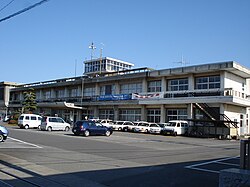Inashiki
Inashiki
稲敷市 | |
|---|---|
 Inashiki city hall | |
 Flag  Seal | |
 Location of Inashiki in Ibaraki Prefecture | |
 Inashiki | |
| Coordinates: 35°57′23.52″N 140°19′26.2″E / 35.9565333°N 140.323944°ECoordinates: 35°57′23.52″N 140°19′26.2″E / 35.9565333°N 140.323944°E | |
| Country | Japan |
| Region | Kantō |
| Prefecture | Ibaraki |
| Area | |
| • Total | 205.81 km2 (79.46 sq mi) |
| Population (October 2020) | |
| • Total | 39,127 |
| • Density | 190/km2 (490/sq mi) |
| Time zone | UTC+9 (Japan Standard Time) |
| - Tree | Sakura |
| - Flower | Chrysanthemum |
| - Bird | Japanese bush warbler |
| Phone number | 029-892-2000 |
| Address | 3277-1 Edosaki, Inashiki-shi, Ibaraki-ken 300-0595 |
| Website | Official website |

Inashiki (稲敷市, Inashiki-shi) is a city located in Ibaraki Prefecture, Japan. As of 1 July 2020, the city had an estimated population of 39,127 in 14,733 households and a population density of 191 persons per km². The percentage of the population aged over 65 was 37.1%.[1] The total area of the city is 205.81 square kilometres (79.46 sq mi).
Geography[]
Inashiki is located in southern Ibaraki Prefecture, bordered by Lake Kasumigaura to the north and Chiba Prefecture to the south. It is approximately 90 kilometers northeast of Tokyo.
Surrounding municipalities[]
Ibaraki Prefecture
Chiba Prefecture
Climate[]
Inashiki has a Humid continental climate (Köppen Cfa) characterized by warm summers and cool winters with light snowfall. The average annual temperature in Inashiki is 14.3 °C. The average annual rainfall is 1360 mm with September as the wettest month. The temperatures are highest on average in August, at around 26.0 °C, and lowest in January, at around 3.6 °C.[2]
Demographics[]
Per Japanese census data,[3] the population of Inashiki has fluctuated considerably over the past 40 years..
| Year | Pop. | ±% |
|---|---|---|
| 1920 | 34,217 | — |
| 1930 | 36,096 | +5.5% |
| 1940 | 38,246 | +6.0% |
| 1950 | 47,081 | +23.1% |
| 1960 | 45,527 | −3.3% |
| 1970 | 41,443 | −9.0% |
| 1980 | 43,257 | +4.4% |
| 1990 | 45,326 | +4.8% |
| 2000 | 51,284 | +13.1% |
| 2010 | 46,898 | −8.6% |
History[]
The city of Inashiki was established on March 22, 2005, from the merger of the towns of Azuma, Edosaki and Shintone, and the village of Sakuragawa (all from Inashiki District).
Government[]
Inashiki has a mayor-council form of government with a directly elected mayor and a unicameral city council of 20 members. Inashiki, together with neighboring Kawachi, contributes one member to the Ibaraki Prefectural Assembly. In terms of national politics, the city is part of Ibaraki 3rd district of the lower house of the Diet of Japan.
Economy[]
The economy of Inashiki is primarily agricultural, with rice, broccoli, lotus root, kabocha pumpkins as major cash crops.
Education[]
Inashiki has ten public elementary schools and four public middle schools operated by the city government, and one public high school operated by the Ibaraki Prefectural Board of Education.
Transportation[]
Railway[]
Inashiki does not have any passenger railway services.
Highway[]
 Ken-Ō Expressway – Edosaki Parking Area, Inashiki Interchange, Inashiki-Higashi Interchange
Ken-Ō Expressway – Edosaki Parking Area, Inashiki Interchange, Inashiki-Higashi Interchange National Route 51
National Route 51 National Route 125
National Route 125 National Route 408
National Route 408
Local attractions[]
- Edosaki Gion Festival
International relations[]
 Salmon Arm, British Columbia, Canada [4] since February 1990
Salmon Arm, British Columbia, Canada [4] since February 1990
Notable people from Inashiki[]
- Inazuma Raigorō, sumo wrestler
- Tatsuya Kawajiri, mixed martial arts
- Shirō Takasu, admiral in the Imperial Japanese Navy
References[]
- ^ "Ibaraki prefectural official statistics" (in Japanese). Japan.
- ^ Inashiki climate data
- ^ Inashiki population statistics
- ^ "International Exchange". List of Affiliation Partners within Prefectures. Council of Local Authorities for International Relations (CLAIR). Archived from the original on 22 November 2015. Retrieved 21 November 2015.
External links[]
![]() Media related to Inashiki, Ibaraki at Wikimedia Commons
Media related to Inashiki, Ibaraki at Wikimedia Commons
- Official Website (in Japanese)
- Cities in Ibaraki Prefecture
- Populated places established in 2005
- 2005 establishments in Japan
- Inashiki

